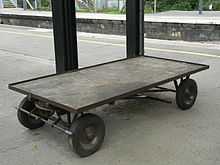Flatbed trolley

Flatbed Trolleys are a common form of transport in warehousing and distribution environments, for moving bulk loads. A very simple design offers a basic flat platform with four casters and a fixed handle which is used to either push or pull the platform with the load on the platform. Flatbed casters can vary dramatically, made of solid rubber, air filled pneumatic or cast iron. The caster is generally the component on the flatbed trolley that limits the safe working capacity.
The frame is usually fabricated steel. The primary flatbed surface can be constructed from wooden boards, plastic, steel or mesh. Without a flat surface it becomes an "open frame" trolley and without a handle it is a bogie or dolly.[1]
Specialised trolleys include the piano dolly, which consistently features small multi-swivel castors and a stronger than usual frame.[2] Modern factory systems commonly track individual trolleys digitally to facilitate automated bills of lading. Automated systems may have remotely operated or autonomous trolleys for transport during storage and access.[3]
The trolley shown at right is termed "a Turntable Trolley" due to its steering mechanism.[4]
References
- ↑ Fazio, Larry (2000), Stage manager : the professional experience, Focal Press, p. 303, ISBN 978-0-240-80410-1
- ↑ "Dolly facilitates piano moving", Popular Mechanics (Hearst Magazines) 49.3, 1928: 524, ISSN 0032-4558
- ↑ Kendall, Kenneth E.; Kendall, Julie E. (2008), Systems analysis and design (7 ed.), Pearson/Prentice Hall, ISBN 978-0-13-224085-7
- ↑ "Trolleys, Sack Trucks & Sack Barrows - Handle-iT, Specialist Manufacturers in The UK". Handle-it.com. Retrieved 2013-05-12.